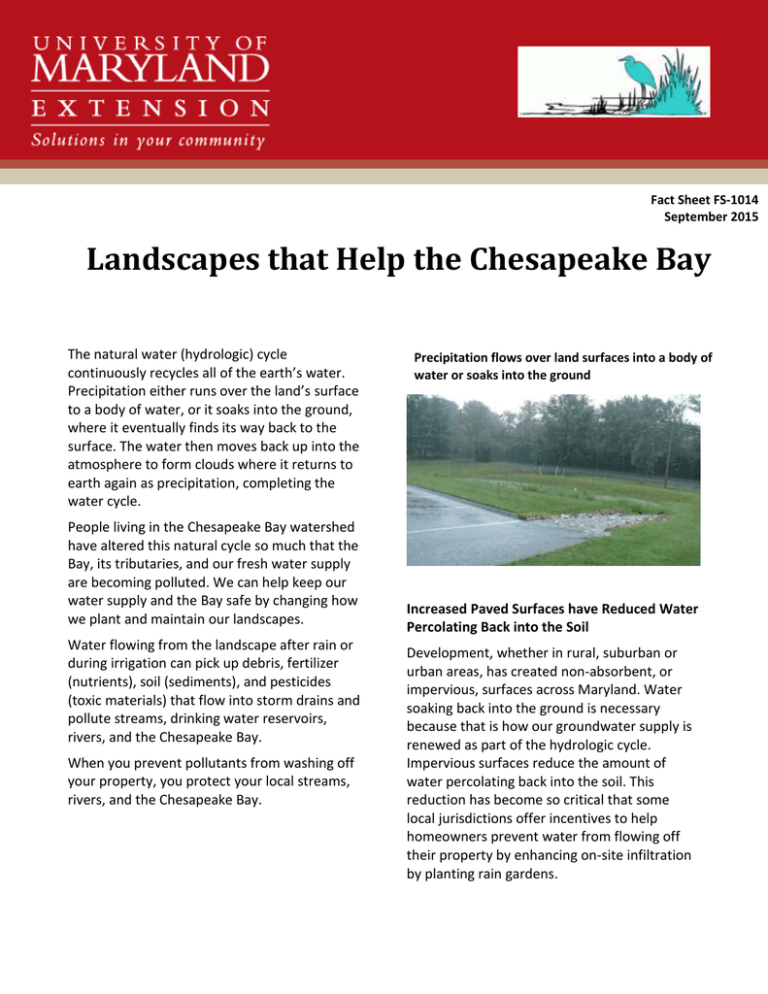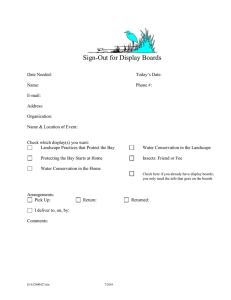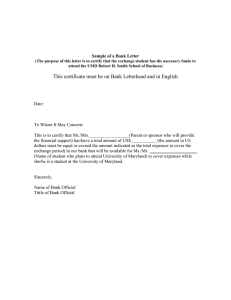Landscapes that Help the Chesapeake Bay The natural water (hydrologic) cycle
advertisement

Fact Sheet FS-1014 September 2015 Landscapes that Help the Chesapeake Bay The natural water (hydrologic) cycle continuously recycles all of the earth’s water. Precipitation either runs over the land’s surface to a body of water, or it soaks into the ground, where it eventually finds its way back to the surface. The water then moves back up into the atmosphere to form clouds where it returns to earth again as precipitation, completing the water cycle. People living in the Chesapeake Bay watershed have altered this natural cycle so much that the Bay, its tributaries, and our fresh water supply are becoming polluted. We can help keep our water supply and the Bay safe by changing how we plant and maintain our landscapes. Water flowing from the landscape after rain or during irrigation can pick up debris, fertilizer (nutrients), soil (sediments), and pesticides (toxic materials) that flow into storm drains and pollute streams, drinking water reservoirs, rivers, and the Chesapeake Bay. When you prevent pollutants from washing off your property, you protect your local streams, rivers, and the Chesapeake Bay. Precipitation flows over land surfaces into a body of water or soaks into the ground Increased Paved Surfaces have Reduced Water Percolating Back into the Soil Development, whether in rural, suburban or urban areas, has created non-absorbent, or impervious, surfaces across Maryland. Water soaking back into the ground is necessary because that is how our groundwater supply is renewed as part of the hydrologic cycle. Impervious surfaces reduce the amount of water percolating back into the soil. This reduction has become so critical that some local jurisdictions offer incentives to help homeowners prevent water from flowing off their property by enhancing on-site infiltration by planting rain gardens. For more information on this and other topics visit the University of Maryland Extension website at www.extension.umd.edu 1 In the past, residential areas were designed to encourage rainwater to exit properties quickly and efficiently. With increased development, this strategy overloaded local creeks with stormwater following heavy rains, leading to degraded natural areas. Communities now have more paved areas than in the past. Residential developers have adopted newer designs that allow water to stay on site and soak into the ground to replenish the groundwater supply. These newer designs also lessen the damage to local streams. Existing landscapes can be redesigned to meet newer stormwater management requirements by incorporating the following recommendations. The yard care practices described here can lead to healthier landscapes and an improved environment by preventing or minimizing pollutants from entering our waterways. Keep Paved Areas to a Minimum Impervious surfaces, like rooftops, driveways, walkways and patios, don't allow water to soak into the ground. Any rain or irrigation water that runs off a property will carry soil, debris, fertilizer, pesticides and other substances from yards into neighborhood storm drains that lead to local streams, rivers, drinking water reservoirs and the Chesapeake Bay. These substances can harm living organisms, habitats and water quality. Water that drains off quickly not only takes pollutants with it but can lead to heavier flow and stream channel erosion. Reducing runoff from your property minimizes these problems. One easy way to do this is to avoid compacting the soil. Create paths to get from one part of the landscape to another and, once established, walk only on those paths. This will encourage stormwater infiltration by decreasing compacted areas. If you are planning to install a path, walk, or patio, you can minimize impervious surfaces by using any of the following materials instead of concrete or brick and mortar: - Gravel - Wood chips - Stepping stones - Permeable/pervious pavers - Bricks or pavers on sand (without mortar) - Wood decks Control the Flow of Water from Your Yard Plants slow down and spread out the force of raindrops that can dislodge soil. They also slow the flow of water over the ground. A lawn creates less runoff than a paved surface. A landscape covered by multiple layers of plants (trees, shrubs and groundcovers) creates less runoff than land covered by just a lawn. A forested area has little runoff. - Maintain dense, healthy plant cover over your whole yard. - Direct the downspouts from your house so that they discharge to grassy areas or planting beds where the water can soak in. Use splash blocks to soften the impact. - Use rain barrels to catch rain water from downspouts, which can be used later to water landscape plants. - Take advantage of low-lying areas in your yard by planting plants that can tolerate “wet feet.” Examples include swamp milkweed, bee balm, New England aster, boneset, joe-pye weed, cardinal flower and New York ironweed. - Plant a rain garden so that it receives roof runoff water rather than allow it to exit your property. For more information on this and other topics visit the University of Maryland Extension website at www.extension.umd.edu 2 Downspouts should discharge to grassy areas or planting beds rather than driveways or sidewalks (yellowing leaves), suspect manganese toxicity. Instead, use pine bark or needle mulch on azaleas and other acid-loving plants. Rethink Your Lawn Healthy turf does an excellent job of protecting soil, slowing runoff, and trapping pollutants, but the basic upkeep takes energy, time, soil amendments, and money. You can conserve all of these in the following ways: Use Mulched Planting Beds Group plants in mulched beds instead of placing them individually around the yard. This technique creates a more natural look in the landscape and makes watering and weed control much easier. Mulched planting beds: - provide an area to recycle yard wastes (small twigs and compost); - protect plants, especially trees, from lawn equipment; - moderate soil temperatures; - conserve water; - help control weeds; and - add organic matter to soil. Do not pile mulch more than 2 inches deep. Avoid using shredded hardwood bark mulch on azaleas. Over time, manganese builds up in the decomposed mulch. Azaleas are susceptible to manganese toxicity. If the soil pH is in the optimal range for azaleas when tested and symptoms look similar to iron chlorosis - Reassess your need for lawn area. Weigh the benefits of scenery, sitting areas, and play areas against the cost of maintenance. If you have more lawn than you need, consider making it smaller. Your needs will change as your lifestyle changes. - Create mulched planting beds. Fill them with flowers, groundcovers, trees and shrubs. Use as many native plants as you can. They require less overall maintenance; and if planned well, the beds can provide four seasons of interest. Publication HG #120, Native Plants of Maryland: What, When and Where, available online from the Home & Garden Information Center (HGIC), offers many choices of native plants. - Consider ground covers. In some parts of the yard, grass can be difficult or impossible to grow or mow. An area may be too shady, rocky, or hilly. Sometimes you can improve the conditions, but it may be easier to plant something more suitable for the site. Many ground covers are less demanding than turf. If moss is already growing in an area, consider encouraging it as a shade-loving groundcover. https://pubs.ext.vt.edu/430/430-536/430536_pdf.pdf. Table 1 has some good choices. For more information on this and other topics visit the University of Maryland Extension website at www.extension.umd.edu 3 Avoid Damaging Underground Utility Lines At least one week before you plan to dig a hole to plant anything in your landscape, call Miss Utility at 1-800-257-7777, 811 or contact online at http://www.missutility.net/iticlite/. Someone will come out to your site to mark off all underground lines. Conserve Water According to the Environmental Protection Agency (EPA), the average U.S. household uses more water outdoors than for showering and washing clothes combined. Water-saving landscape practices reduce runoff and help keep pollutants out of the storm drains that empty into waterways feeding the Bay. More importantly, the less water we use for landscaping, the more that is available for necessities like drinking and food preparation. Conserving water in the landscape can also save money. Why spend money on water for landscape plants when you can get it without cost from nature or avoid the need for it? Here are some ideas: - Use plants adapted to this region. They can better withstand Maryland’s periodic droughts. If a "problem" plant dies in your landscape, replace it with a non-invasive, drought-tolerant or native one suitable to the site, i.e., shady, sunny, wet or dry areas. For a more comprehensive list of groundcovers, view Ground Covers, Home and Garden Information Center, University of MD Table 1. Groundcovers can be a good choice in areas where grass is difficult to grow Plant Alleghany Pachysandra* Pachysandra procumbens Bearberry* Arctostaphylos uva-ursi Bearberry Cotoneaster Cotoneaster dammeri Black Huckleberry** Gaylussacia baccata Blue Fescue* Festuca ovina v. glauca Candytuft Iberis sempervirens Checkerberry or Creeping Wintergreen** Gaultheria procumbens Christmas Fern** Polystichum acrostichoides Creeping Juniper* Juniperus horizontalis Foamflower** Tiarella cordifolia Lilyturf, Mondo Grass Ophiopogon japonicas Liriope Liriope muscari Maidenhair Fern** Adiantum pedatum Mountain stonecrop** Sedum ternatum Partridgeberry** Mitchella repens Wild Ginger** Asarum canadense Height Conditions 6-12" Sh* 6-12” S, PSh 12-18” S 18” PSh, Sh 6-8” S 6-12” Sh 6” Sh 18-24” PSh 12-24” S 12” S, Sh 3-15” S, Sh 18” S, Sh 12-24” PSh 4-8” PSh, Sh 1-2” S, Sh 12” PSh, Sh S = sun, Sh = shade, PSh = part shade, *native to the U.S., **native to Maryland For more information on this and other topics visit the University of Maryland Extension website at www.extension.umd.edu 4 Use native species and group plants to minimize need for watering - Try xeriscaping--using plants that are extremely drought tolerant. View the HGIC publication, Xeriscaping and Conserving Water in the Landscape, HG 25, for more information. - If you want certain plants in your landscape that require regular watering, group them so that you can water all of them at once and minimize waste. - Keep weeds to a minimum. Weeds compete with landscape plants for water and nutrients. Eliminating weeds provides more water and nutrients for desirable plants. - Avoid watering on windy days. Wind causes water to evaporate before it has a chance to get down to the plant roots. - Water your lawn only when the grass shows signs that it needs water. The lawn will develop a blue-gray color and will leave footprints when you walk on it if it needs water. Apply water slowly to a depth of at least 4-6 inches. Light, frequent watering can actually damage your lawn. Water in the morning to minimize moisture loss due to evaporation. A newly seeded or newly sodded lawn must be watered regularly until it is established. Unless you have bluegrass, allow a mature lawn to go dormant during dry spells. Dormancy during dry weather is a survival mechanism and the lawn will usually recover when rainfall returns. Leave Buffer Strips Waterfront property doesn’t always mean a cottage on a picturesque river or lake. A small stream or even a drainage ditch on your property can be considered waterfront. If you live next to a ditch, stream, lake, or other body of water, consider leaving a 25-foot or wider strip of unmown grass or woodland (called a riparian buffer) along the water. This will: - Collect rainwater in rain barrels to use later. Screen openings in the rain barrel to prevent mosquitoes from breeding there. - slow water runoff and soil erosion; - Use soaker hoses or drip-irrigation instead of a sprinkler. The initial installation cost might be higher, but these devices do the job with much less water, and send the water right where it's needed. - provide food and shelter for wildlife. - filter water pollutants; and If you don’t have space for a 25-foot buffer, leave at least some distance between the mowed area and the water’s edge. Mowing right up to the water’s edge is not a good practice. For more information on this and other topics visit the University of Maryland Extension website at www.extension.umd.edu 5 Buffer strips slow water runoff and reduce soil erosion - Try mechanical controls of pests and diseases such as hand-picking, trapping, or pruning. - If you decide to use a pesticide, choose the least toxic one with the shortest residual that will be effective. - Learn to identify and appreciate beneficial insects. Conserve Energy Choose Efficient Landscape Maintenance Equipment Deal With Pests Sensibly In addition to controlling pests, many pesticides can harm or damage non-target entities like the person applying the pesticide, other people, pets, fish, birds, wildlife, beneficial insects, nontarget plants, play sets, and vehicles. Learn more from the HGIC publication, IPM: A Common Sense Approach (FS-62). You can reduce or eliminate the use of traditional pesticides in your home landscape and still have a desirable lawn or garden. The basics of Integrated Pest Management (IPM) are: - plant a variety of species to avoid widespread damage from a single disease or pest; - use disease and insect-resistant plants; and - monitor your landscape to catch problems early. If your plants have problems, first consider their basic needs like proper pH, soil fertility, and drainage. Many potential pests don't need to be controlled with pesticides. - Learn to distinguish between minor damage and significant attacks. Emissions from burned fossil fuels deposit pollutants directly in the waters of the Chesapeake Bay and on land where they can be washed into streams. Actions taken outside around the home to lower energy use and demand can help reduce pollution. Use a non-polluting reel mower to mow small areas. If considering using an electric mower, know the source of your electricity. Coalburning power plants pollute the air. If a gaspowered mower is necessary, use an energyefficient one with a cleaner burning engine. On air quality code-red days, avoid filling the gas tank and mowing during the hottest part of the day. Design Landscape for Energy Efficiency Since Maryland is in the temperate part of the country, there are four ways to use landscaping to reduce energy consumption. Thoughtful landscape design can maximize warming effects of the sun in the winter, optimize shade during the summer, deflect winter winds away from buildings, and direct summer breezes toward the home. If strategically placed, trees and shrubs can lower costs to heat and cool a house. Landscape plants also benefit the environment as they store carbon and produce oxygen. Here For more information on this and other topics visit the University of Maryland Extension website at www.extension.umd.edu 6 are ways you can lower your energy needs while protecting the bay and our environment: - Plant evergreen trees to the north and northwest of the house to protect it from winter winds. - Deciduous trees planted on the south and southwest sides block the sun during the summer and allow the sun to penetrate and warm the house during the winter. April 1, 2015, from http://www.epa.gov/watersense/outdoor/inde x.html “Landscape Windbreaks and Efficiency." Energy.gov. N.p., 13 Apr. 2012. Web. 01 Apr. 2015. http://energy.gov/energysaver/articles/landsca pe-windbreaks-and-efficiency - Plant shrubs to reduce energy consumed by heating and air conditioning units. Strategically placed shrubs planted next to an air conditioner unit can shield it from the hot summer sun, making it run more efficiently. But allow enough space (12-18 inches) between shrub and unit for good air circulation. Secord, J. (Ed.). (2014, April 10). Landscaping for Water Quality: Garden Designs for Homeowners, 3rd Edition. Retrieved April 1, 2015, from http://www.michigan.gov/documents/deq/wrd -nps-landscape4wq_401217_7.pdf - Create an insulating barrier by planting shrubs along the house’s foundation. Consider the mature size of the shrubs. Plant so that there will be 12-18 inches between the house and the full-sized shrubs. Urban Nonpoint Source Fact Sheet. EPA 841-F03-003. (2014, May 21). Retrieved April 1, 2015, from http://water.epa.gov/polwaste/nps/urban_fact s.cfm References Slattery, Britt E., Kathryn Reshetiloff, and Susan M. Zwicker. 2003. Native Plants for Wildlife Habitat and Conservation Landscaping: Chesapeake Bay Watershed. U.S. Fish & Wildlife Service, Chesapeake Bay Field Office, Annapolis, MD. 82 pp. http://www.nps.gov/plants/pubs/chesapeake/pdf/c hesapeakenatives.pdf EPA WaterSense. Outdoor Water Conservation & Sustainable Landscaping. (n.d.). Retrieved Peter Riccuiti and Wanda MacLachlan (wtm@umd.edu) This publication, Landscapes That Help the Chesapeake Bay (FS-1014) is part of a series of publications of the University of Maryland Extension and the Bay-Wise Program. The information presented has met UME peer review standards, including internal and external technical review. For more information on related publications and programs, visit: http://extension.umd.edu/baywise. Please visit http://extension.umd.edu/ to find out more about Extension programs in Maryland. The University of Maryland, College of Agriculture and Natural Resources programs are open to all and will not discriminate against anyone because of race, age, sex, color, sexual orientation, For more physical information or mental disability, on thisreligion, and other ancestry, topics or national visitorigin, the marital University status, genetic of Maryland information,Extension or political affiliation, website or gender at www.extension.umd.edu identity and expression. 7



